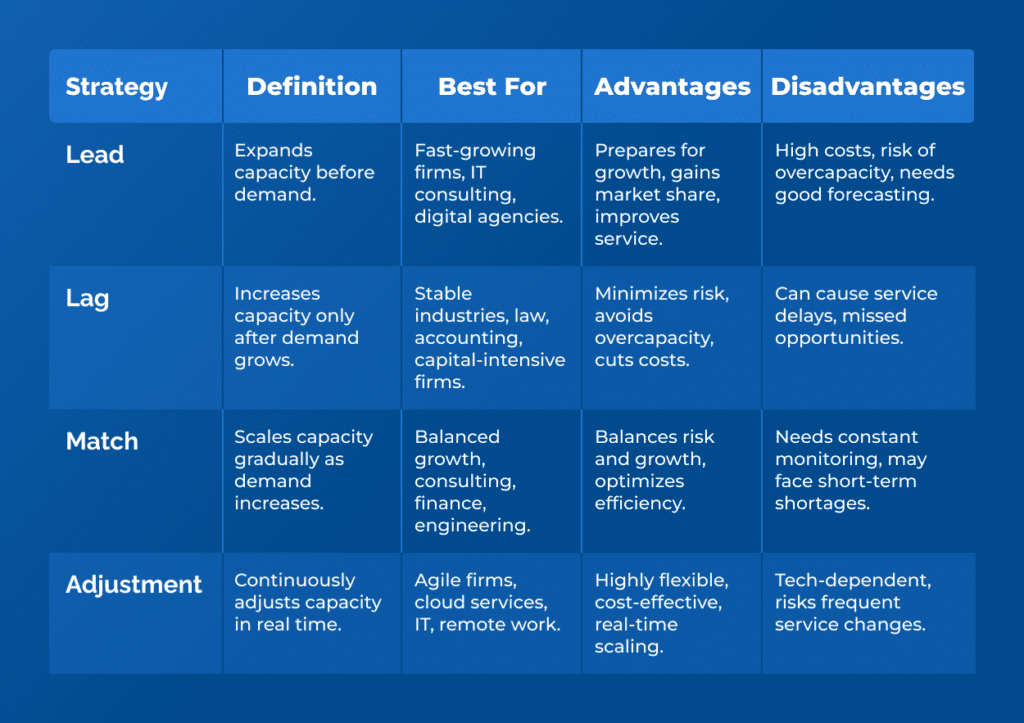For professional services organizations, effective capacity management is vital for a number of reasons – profitability being the main one. With proper capacity management, it can go through the roof. But what if that process is somehow lacking?
Don’t let poor capacity management hinder your organization’s success. Read on to learn more about the effects of this process, the benefits of capacity management, and discover strategies for maximizing project profitability.
What’s in this article?
- What is capacity management? Definition
- How capacity management boosts profitability?
- What are the best capacity management strategies?
- What is the impact of poor capacity management on businesses?
What is Capacity Management?
How well you manage your staff can either make or break your professional services organization. When you practice effective capacity management, you’re optimizing your team’s time so you can meet current and future needs.
The main goal of capacity management is to find the right balance between what’s available and what’s needed, ensuring consistent and reliable delivery without wasting resources. By anticipating future demand, evaluating current resource capacity, and adapting to changes in resource availability, capacity management helps businesses make smart choices, work more efficiently, and grow while controlling expenses.
How the Right Resource Management Strategy Can Help Boost Project Profitability
Implementing effective capacity management strategy can be a pivotal factor in boosting project profitability for professional services firms. Why? Because one of the benefits of capacity management is its ability to boost profitability not with additional projects, but with better resource allocation – as you can see in the example below.
An effective capacity management approach ensures that a company’s most valuable assets are allocated efficiently to align with project demands. As a result, organizations can navigate economic fluctuations more effectively, reduce operational costs, and elevate overall project productivity.
This not only enhances resilience during challenging economic periods but also positions companies to capitalize on growth opportunities when market conditions improve. It also helps improve client satisfaction by consistently delivering projects on time and within budget, ultimately contributing to sustained profitability and a competitive advantage in an ever-evolving business landscape.

Four Capacity Management Strategies For Professional Services Companies
Effective capacity management seeks improved utilization rates, and a maximum use of available resources in upcoming projects. Still, there is more than one way to achieve that, as capacity management encompasses numerous methods and techiques that can be used for resource allocation. Here are the most popular of them.

Lead Strategy – The Proactive Expansion Strategy
The lead strategy involves expanding capacity in anticipation of future demand growth. Companies using this approach invest in additional resources, infrastructure, or personnel before demand increases, ensuring they are fully prepared when the need arises. This strategy is common in industries where securing capacity in advance provides a competitive advantage, such as large-scale manufacturing, construction, and technology firms launching new products.
Lead Strategy – Advantages
- Ensures readiness to meet rising demand with rapid expansion of human resources.
- Helps capture market share before competitors.
- Improves customer satisfaction by reducing service delays.
Lead Strategy – Disadvantages
- Risk of excess capacity if demand does not materialize.
- High upfront investment costs.
- Potential inefficiencies if demand forecasts are inaccurate.
Lag Strategy – The Reactive Adjustment Strategy
The lag strategy involves increasing capacity only when demand has already risen, without predicting future capacity from the long-term perspective. This reactive approach minimizes costs by ensuring that additional resources are only added when absolutely necessary. It is commonly used in industries with high capital expenditures, such as utilities, construction, and manufacturing, where over-investment could lead to significant losses.
Professional Services Suitability
Professional services firms with stable demand patterns, such as law firms or accounting firms, often prefer this strategy. It allows them to avoid unnecessary expenses and maintain lean operations. Firms in highly specialized or niche markets, where hiring too soon could result in idle staff, also benefit from a lag strategy.
Lag Strategy – Advantages
- Reduces financial risk by avoiding unnecessary expansion.
- Ensures resources are fully utilized.
- Maintains a lean, cost-efficient operation.
Lag Strategy – Disadvantages
- May lead to lost business opportunities due to service delays.
- Can strain existing staff, impacting service quality.
- Limits ability to respond quickly to sudden demand surges.
Match Strategy – The Incremental Scaling Strategy
The match strategy takes a balanced approach by gradually increasing capacity in small, controlled increments as near future demands grow. It seeks to maintain equilibrium between demand and resource capacity, ensuring that firms are neither underprepared nor overinvesting. This method is widely used in industries with moderate demand fluctuations, such as logistics, retail, and manufacturing.
Match Strategy – Advantages
- Provides a flexible, risk-mitigated approach to growth.
- Helps maintain optimal efficiency while preparing for demand shifts.
- Minimizes costs compared to a lead strategy while reducing service delays seen in a lag strategy.
Match Strategy – Disadvantages
- Requires constant monitoring and forecasting.
- May still result in temporary capacity shortages during unexpected surges.
- Can be difficult to implement in fast-changing industries.
Adjustment Strategy – The Dynamic Optimization Strategy
The adjustment strategy involves adding employees to tasks or projects in response to real-time demand fluctuations. It is commonly used in industries with rapidly changing demand patterns, such as cloud computing, e-commerce, and customer service centers. This strategy relies on technology, automation, and outsourcing to scale operations dynamically.
However, for this business capacity management technique to be effective, managers often rely on capacity management tools to gather information on resource availability, future capacity, and any changes in upcoming projects.
Adjustment Strategy – Advantages
- Offers maximum flexibility to respond to real-time market changes.
- Optimizes resource usage by scaling up or down efficiently.
- Reduces long-term financial commitments by using outsourcing or contract-based staffing.
Adjustment Strategy – Disadvantages
- Requires advanced data analysis and forecasting capabilities for future demand.
- Can be challenging to implement without strong technology infrastructure.
- Risk of service inconsistencies if adjustments are too frequent.
Capacity Management – Best Practices
Of course, effective capacity management requires more than just the choice of the right business process. To enhance your project planning and operational efficiency, you also need to monitor available resources, pasts projects, and adapt resource planning to both business needs and market trends. Here’s how to do that.
Forecast Demand Accurately
Accurate resource capacity forecasting is the backbone of capacity management strategies. Businesses should analyze historical data, market trends, and economic indicators to predict future needs and improve capacity planning in the long-term. Using AI-driven analytics and demand modeling helps anticipate fluctuations, helping managers prioritize projects and avoid underutilized resources regardless of the future capacity needs.
Monitor and Optimize Resource Utilization
Tracking key performance indicators (KPIs) like employee productivity and asset usage helps businesses identify inefficiencies in their resource management. Capacity management tools and automation can optimize resource allocation and eliminate bottlenecks in operation using historical data and informing managers about any capacity issues, such as schedule conflicts or overbooking.
Develop Contingency Plans
Capacity management should include planning for unexpected disruptions in project timelines such as demand surges, supply chain issues, or staffing shortages. Having backup resources, alternative suppliers, and response strategies ensures business continuity during crises without worrying about sudden capacity constraints.
Use Technology for Better Decision-Making
Technology plays a key role in capacity management. Organizations should implement AI-powered analytics, ERP systems, and cloud-based platforms to make data-driven decisions that optimize workforce and resource planning.
Regularly Review and Optimize Capacity Plans
Capacity needs change over time, so businesses must continuously assess and refine their strategies. Conducting periodic audits, monitoring performance data, and staying updated on industry trends help organizations maintain an optimal capacity balance.
The Impact of Poor Capacity Management
Effectively allocating resources to meet client demands and sustain growth has become more complex. Many firms still grapple with these intricacies without dedicated solutions, leading to a range of issues that hinder their potential. In an era where precision, agility, and data-driven decisions are paramount, relying on outdated or makeshift capacity management processes can be detrimental.
If your firm is still using any of the following processes to manage capacity, your project profitability is likely suffering because of it.
- Manual spreadsheets
- Retro-fit project management software
- Collaboration tools like email and Slack
- Ad hoc methods like verbal communication, whiteboards, and sticky notes
Below, we highlight eight of the numerous impacts of inadequate capacity management within professional services firms that significantly affect project profitability, undermining the very foundation of a firm’s success.
Impact #1: Delayed Project Timelines
Poor capacity management process in professional services firms often leads to delayed project timelines. When teams are overloaded with work or resources are not allocated efficiently, bottlenecks can occur, causing delays in project execution and problems with operational efficiency. These delays not only frustrate clients but also disrupt the overall project schedule, affecting the firm’s reputation and potentially leading to financial penalties.
Impact #2: Decreased Productivity
Inadequate capacity management can result in decreased productivity among employees. When teams are stretched thin, employees may struggle to manage their workloads effectively, leading to a drop in their productivity levels. This decreased productivity can have a cascading effect on project delivery, scope creep, client satisfaction, and the firm’s profitability.
Impact #3: Struggling to Scale
As firms aim for growth, poor capacity management becomes a significant hindrance reflected in performance management. The inability to efficiently allocate resources can limit the firm’s ability to take on new clients or larger projects, stifling its growth potential and market competitiveness and hindering business value.
Impact #4: Compromised Quality
One of the most significant impacts of poor capacity management is compromised quality. When professionals are rushed or overwhelmed with work, the quality of their deliverables can suffer. Mistakes and oversights become more common, leading to client dissatisfaction and potential rework, which can further strain the firm’s resources.
Impact #5: Increased Burnout
Excessive workloads and prolonged periods of high stress due to poor capacity management can result in increased burnout among employees. Burnout not only harms individual well-being but also contributes to higher turnover rates, increased absence, and lower morale within the firm, making it challenging to retain top talent.
Impact #6: Lack of Visibility
Poor capacity management often leads to a lack of visibility into resource allocation and project progress. Without a dedicated system, it becomes difficult to track who is working on what and when. This lack of visibility can hinder decision-making and prevent the firm from making necessary adjustments to meet client demands effectively.
Impact #7: Unable to Forecast Utilization Rates
One of the biggest pains that come with not having resource management software is the inability to forecast the utilization of employees. Utilization rates are a crucial metric for all professional services organizations as they dictate how effectively an organization is utilizing its workforce collectively to deliver billable work and whether there is room for improvement.
If you’re using a spreadsheet to keep track of utilization rates and scheduling, it can quickly become a nightmare to update the sheet when sick days and PTO come up to reflect current and accurate forecasts. Avoid this unnecessary and error-prone practice by implementing an automated dedicated capacity management system.
Impact #8: Lower Client Satisfaction
Ultimately, the most critical impact of poor capacity management is lower client satisfaction. Delays, decreased productivity, compromised quality, and other issues directly affect the client’s experience. Dissatisfied clients are less likely to renew contracts or recommend the firm to others, which can have long-term repercussions on the firm’s client base and revenue stream. Maintaining high client satisfaction is essential for the success and growth of professional services firms.
In summary, the consequences of not having a dedicated resource management system in professional services can be extensive, affecting not only project profitability but also employee well-being and overall business success. To thrive in today’s competitive landscape, firms must invest in modern capacity management solutions to address these pain points effectively.
Improving Project Profitability With Professional Services Automation Software
Professional Services Automation (PSA) software like BigTime, seamlessly integrates resource management tools within its feature set, effectively streamlining the entire project lifecycle.
From initial planning and resource allocation to project execution and in-depth analysis, PSA software empowers organizations to optimize their resource utilization. In fact, firms who don’t use dedicated resource management software like BigTime see an average employee billable utilization rate of 67.1% while firms who do use the software see an average employee billable utilization rate of 75.7% (2023 SPI Benchmark Report).
What Other Benefits Of Capacity Management Are Emphasized By Solid Capacity Planning System?
PSA software not only enhances project outcomes but also boosts overall productivity and client satisfaction. When is disconnected from project management and time tracking, it becomes challenging to assess a project’s financials, gauge the efficiency of capacity planning, and track the project’s progress effectively. Integrating these functions within a PSA software platform resolves these issues and ensures a more streamlined, successful, and profitable project management process.
7 Additional Benefits of Capacity Planning Tool
Apart from the ability to create and edit capacity management plans and perform advanced resource calculation, capacity management tools also offer a variety of other benefits, including:
- Resource Utilization Insights: With resource utilization reporting, you can assess how effectively resources are being used and make informed decisions to improve capacity planning.
- Real-Time Resource Availability: BigTime provides a real-time view of resource availability, helping you allocate the right team members to projects without overcommitting.
- Workload Balancing: The workload balancing feature lets you evenly distribute tasks among team members to prevent burnout and optimize productivity.
- Skill Matching and Expertise Alignment: BigTime’s skill matching capability allows you to match tasks with team members possessing the appropriate skills, enhancing project outcomes.
- Custom Resource Categorization: You can categorize resources based on roles, skills, or other criteria, enabling precise assignments and streamlined capacity management.
- Time and Expense Tracking: BigTime seamlessly integrates time and expense tracking data, aligning resource allocation with actual work hours and costs for accurate capacity planning.
- Forecasting and Predictive Analysis: By analyzing historical data, BigTime assists in capacity and utilization forecasting, empowering you to anticipate resource needs for upcoming projects.
These features collectively empower organizations to make strategic decisions, optimize resource utilization, and ensure efficient capacity management through BigTime’s comprehensive capabilities.
Comprehensive Capacity Management Tools In a Single App? It’s Possible with BigTime!
Managing resource capacity, as well as project, finances and human resources, all while improving operational efficiency, is simple with BigTime.
Book a demo with our tool to be in control of any current and future demands, regardless of the circumstances.




